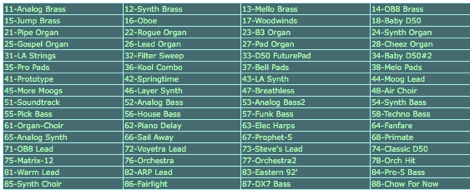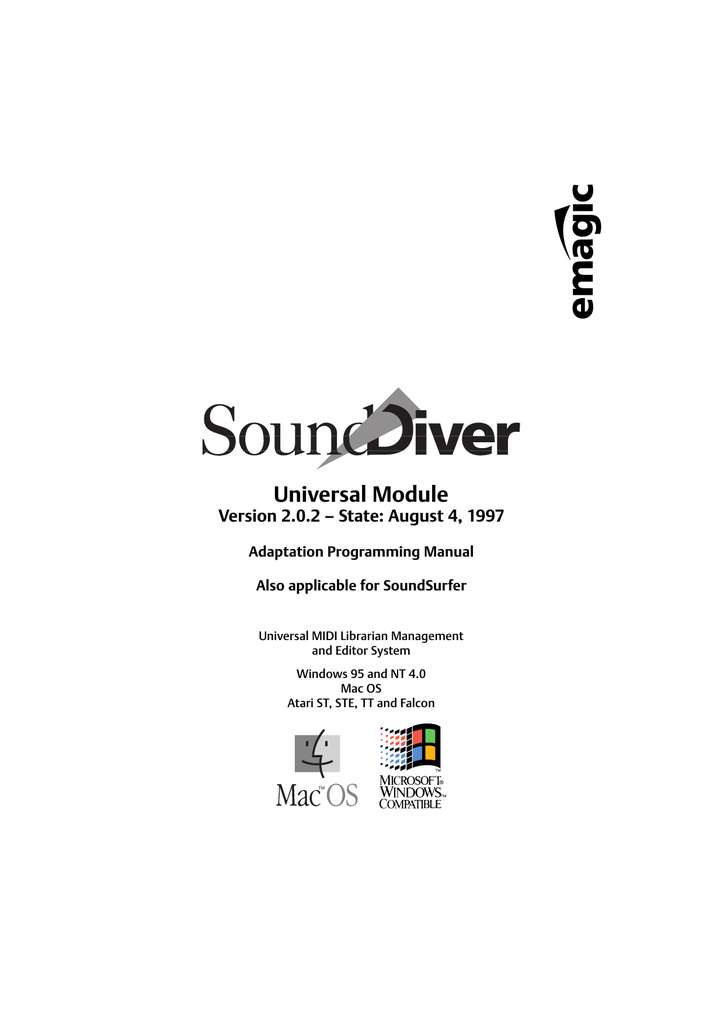
Roland D110 Patch List
Crystal reports 9 full download or descarga. Tight Integration with Office Workflow: With Crystal Reports, providing users with seamless access to report information in popular formats and environments is easy.
Outline of the D-110 Structure and Editors
The editor works in the D-110's Multi-Timbral mode. Performance mode works a little differently, and doesn't exactly apply to what I outline here.
First off, the difference between a Tone and a Timbre: A Tone is where the real meat of a sound is set up. In the patch editors of Patch Base for the D-110, you're editing Tones (selecting the sample, changing the Filter, Amp, etc). A Timbre is just a little bit of info that selects which saved Tone (from the synth's memory) should be played, changes the tuning if you want, and turns Reverb on or off.
The D-110 has 3 banks of Tones: A, B, and Internal (or 'Int'). A and B are just read-only presets. The Internal bank is the only one you can write to. So, when you go to the 'Tone Bank' tab, you're fetching or sending the 64 tones in the Internal Tone Bank, since A and B can't be changed.
October 28 software house. 10 Type: All Data Dump Note: it all tones not all memory dump for d110 these are older transistor type sounds mainily made by me but few are from other library.sounds like jupitar,tb303,z-zrp,juno etc use a sys ex sender,will overwrite existing tones 64 voices in total email me with comments also interested in music making with others! Roland Boutique D-05 / D50 - 32 Free Synth Patches FREE synthesizer patches for the Roland Boutique D-05 & D50. 32 carefully crafted sounds for the modern & classic versions of this iconic Roland synthesizer. All patches Paul Barrett 2018 To get these patches on to your Roland Boutique D-05 you will need to do the following: 1.
The D-110 also has 128 Timbres that can be stored. When you select a Timbre on the synth, those 128 are broken up into A and B banks. So the first major point of confusion (for me at first, and others) is that there's an A and B bank of Timbres, and also Tones. But for Timbres, that A and B bank are the ones you can save to, whereas for Tones, A and B are the presets.

On the synth, when you select A or B and hit a number, you're recalling a saved Timbre, which in turn loads a Tone. What you're doing is essentially updating the Timbre data for your selected Timbre (which you can also see in the Timbres tab). E.g., try selecting a Timbre on the synth itself, then doing a 'Fetch' in the Timbres tab, and you'll see that the Timbre data changes in the editor.
Patch Base doesn't support saving Timbres yet. It needs a 'Timbre Bank' tab added that will allow for that. This is something I plan on adding, and I'm sorry it's not there yet. These synths are just a very different structure from pretty much all others, and I've had a hard time designing around it.
In Multi-Timbral mode, you have 8 different loaded 'Timbres' you can play. Timbre 1 is played on MIDI Channel 1, Timbre 2 on channel 2, etc. This is hard-wired in the D-110. Each Timbre has 1 Tone assigned to it.
So, in the Timbres tab, all you're really doing is specifying, for each Timbre, which saved Tone should be used. Tone Group picks which bank you're choosing from (presets vs. internal), and Tone Number is the number of the tone used. In an update I'll make it so that 'Tone Number' is actually showing you the names of the Tones instead of just the number.
Carolina crown brass manual. The Tone 1, 2, 3, etc tabs are there to fetch and edit the currently loaded Tone for each of the 8 Timbres.
So the best way to use the editor right now is to design sounds in the Tone 1, 2, etc tabs, and when you have some you want to save, save them to the Internal bank on the synth. Then, set up your Timbres to use those sounds that you want, so that when you load a Timbre by selecting A or B and hitting the number buttons, you're loading a Timbre that loads the Tone you created. BUT, saving that Timbre configuration is still something you have to do on the synth itself. You can edit the Timbres from Patch Base, but the saving you have to do manually.
Related Pages
- Roland D-110 Editor in Patch Base
Editors for Roland D-110, D-10, D-20, and D-5 Added in Patch Base 2.9by Chadwick Wood.December 12th, 2017About a month ago, my regular Craigslist search for synths in the Austin area turned up a Roland D-10 at a too-good-to-be-true price! It looked like it needed some love, but the guy assured me that it worked very well. So we met up at a coffee shop and made the transaction.
I got home, plugged it in, and what do you know: a few of the panel buttons didn't work, the outputs cut out sometimes, and the middle E key doesn't work at all. Rather than bother pestering the guy who lied to me, I figured that I could still make an editor for it, even with the broken buttons. And maybe a little later on I can get the wizards at to do some repairs on it.But that's all to say that today bears the fruits of that sketchy Craigslist purchase: adds editors for the Roland D-10, as well as its siblings the D-110, D-20, and D-5. And for the next few days, they're each 25% off. Grouped all together, they're one of the most-requested families on the.
All of these synths share a lot in common with, but they're a little more on the budget side, and they're just as confusing to program from the panel!These new editors work in the synth's Multi-Timbral mode, allowing you to edit the Tones on the synth (each Tone has 4 Partials). The 'Timbre Sync' button at the bottom puts the editor in sync with the selected Part you're working with, so you can change the transposition, overall output, and edit the Reverb settings. The editors are made with the hope that you won't have to know much about what a Tone, Partial, Timbre, or Part is(!) and you can still use them. Roland loves to make things complicated, and Patch Base tries to simplify them.
Below are a couple of screenshots of the new editors, one editing a partial that uses a digital oscillator, and the other that uses one of the PCM samples:.